|
|
|
Sort Order |
|
|
|
Items / Page
|
|
|
|
|
|
|
| Srl | Item |
| 1 |
ID:
183031
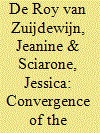

|
|
|
|
|
| Summary/Abstract |
Many European countries have been the target of jihadist terrorist attacks between 2015 and 2017. While the chance of becoming a victim of a terrorist attack is low, terrorism scholars have emphasized that terrorism does not revolve around statistics and casualty numbers. Terrorists use attacks to reach an audience and affect groups beyond the direct victims. To this date, little is known about how terrorist attacks might affect the salience of terrorism beyond national borders. This paper investigates possible convergence of issue salience of terrorism among citizens within the European Union for ten jihadist attacks in the period 2015–2017 using Eurobarometer survey data. The results indicate that it is not simply a question of convergence or divergence of salience of terrorism after a terrorist attack. The connection is multidirectional and depending upon a variety of factors. Most importantly, we observed convergence on the EU-level, but divergence on the national level. This raises important questions about the transnationality of the effects of terrorism. As this research does not test nor find a causal mechanism and is solely dependent on existing data, further research is necessary to test some of its findings.
|
|
|
|
|
|
|
|
|
|
|
|
|
|
|
|
| 2 |
ID:
086001
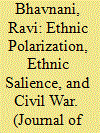

|
|
|
|
|
| Publication |
2009.
|
| Summary/Abstract |
This article examines how the relationship between ethnic polarization and civil war could be moderated by different degrees of ethnic salience. Using an agent-based computational model, we analyze the polarization-conflict relationship when ethnic salience is ``fixed''-high for every member of two nominally rival ethnic groups- and ``variable''-permitted to vary across individuals as a function of relative income. We find that (1) when salience is fixed, conflict onset is twice as high at low levels of polarization compared to when salience is permitted to vary, with the difference decreasing at high levels of polarization; (2) the relationship between conflict onset and the range over which we calculate variable salience is positive and robust for low and moderate levels of polarization; (3) the relationship between polarization and conflict onset is robust even under minority domination, if one holds salience fixed; and (4) holding ethnic salience fixed effectively amplifies the negative effect of polarization on economic performance.
|
|
|
|
|
|
|
|
|
|
|
|
|
|
|
|
| 3 |
ID:
090756
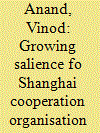

|
|
|
| 4 |
ID:
133154
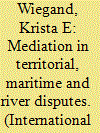

|
|
|
|
|
| Publication |
2014.
|
| Summary/Abstract |
This article seeks to explain factors that make mediation attempts more or less likely in territorial, maritime, and river disputes. I argue that the intensity of the dispute and the salience of disputed territory have strong influence on mediation attempts. The study further examines the impact of these factors on the type of mediation strategy (directive, procedural, or communications). Hypotheses about mediation attempts are tested with the icow data set of interstate territorial, maritime, and river disputes from 1816 to 2001. Findings indicate that intensity of the dispute and salience of disputed territory have a strong impact on the selection of mediation in the first place, and second, that salience of disputed territory makes the directive strategy more likely, while intensity of the dispute makes procedural or communications strategies more likely.
|
|
|
|
|
|
|
|
|
|
|
|
|
|
|
|
| 5 |
ID:
164437
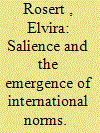

|
|
|
|
|
| Summary/Abstract |
This article theorises salience – defined as the amount of attention granted to an issue – as an explanatory factor for the emergence and non-emergence of norms, and shows how salience affects existing explanations such as issue adoption by norm entrepreneurs, mobilisation, social pressure, and framing. The relevance of salience is demonstrated by exploring the question of why the norm against incendiary weapons was adopted in the Convention on Certain Conventional Weapons (CCW) in 1980, and why the norm against cluster munitions was not, even though both weapons were deemed particularly inhumane and thus, put on the agenda when the CCW negotiations started in 1978. Drawing on secondary sources and on original data from public and institutional discourses, I study the influence of salience on the emergence of the anti-napalm norm and the non-emergence of the anti-cluster munitions norm in the period of 1945–80. The results demonstrate that and how the discrepancy in salience of the napalm and the cluster munitions issues mattered for the outcomes of the two norm-setting processes.
|
|
|
|
|
|
|
|
|
|
|
|
|
|
|
|
| 6 |
ID:
148791


|
|
|
|
|
| Summary/Abstract |
How has the salience of democratic governance varied as an issue and as a basis of social status in the United Nations General Assembly (UNGA) over time? International Relations (IR) scholars typically assume a high salience of democratic governance in international society after the Cold War, yet evidence suggests important fluctuations and that these assumptions should be qualified. This article presents quantitative and qualitative results of a manually-coded content analysis of the UNGA General Debates between 1992 and 2014, with comparison to 1982, illustrating variation in the frequency and content of state representatives’ references to democracy and the use of democratic governance as a symbol of status. What factors influence the salience of a given dimension of social status in an international organisation? Explanations supplement IR approaches with insights from social psychology, including the relevance of high and low identifiers, accessibility, fit, current and anticipated group status, and regional status concerns. The article analyses trends in states’ support for principles underpinning international order, which have broader implications for literature on global governance and status in world politics as well as for international democracy support.
|
|
|
|
|
|
|
|
|
|
|
|
|
|
|
|
| 7 |
ID:
115240


|
|
|
|
|
| Publication |
2012.
|
| Summary/Abstract |
The purpose of this research note is to provide an empirical indication of how China's increasing role in the South Pacific has been presented in their own and other nations' media over the last 20 years. What is the tone of coverage? Which issues are salient? How does this vary by nation? What changes are there over time? This research note reports information derived from over 1000 articles published in Australasian, Asian and Pacific newspapers in the last 20 years. The findings demonstrate that nations dealing with 'China's rise' in the South Pacific are faced with a range of complex issues, which can produce ambivalent and mixed reactions. For instance, although the tone of Australian and New Zealand newspaper coverage of China's entry into their 'special patch' is, overall, more negative than positive, negativity is largely driven by coverage of China's diplomatic efforts in the region and geopolitical considerations. Other aspects of China's expanding role (e.g. economic and cultural aspects) are treated much more positively. Similarly, although the major focus of Pacific newspapers is on Chinese aid and economic impact, which are treated very positively, coverage of other issues can be negative.
|
|
|
|
|
|
|
|
|
|
|
|
|
|
|
|
| 8 |
ID:
120135
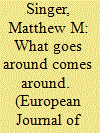

|
|
|
|
|
| Publication |
2013.
|
| Summary/Abstract |
Voters who perceive the economy to be weak are generally less likely to support the incumbent government. Yet there is a debate over whether all people respond equally to economic shifts or if the state of the economy is more salient for those who feel economically vulnerable. This article examines whether insecure employment situations and employability concerns strengthen responses to the government's economic record. Data from Latin America and Eastern Europe confirm that workers who feel anxious about being fired or who believe it would be difficult to find a new job place significantly greater weight on sociotropic evaluations than do those with more secure employment situations. Thus incumbents who create risks for vulnerable workers are sanctioned, while those who create opportunities are rewarded most.
|
|
|
|
|
|
|
|
|
|
|
|
|
|
|
|
| 9 |
ID:
178177
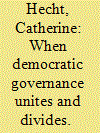

|
|
|
|
|
| Summary/Abstract |
Scholars and practitioners are increasingly attentive to contestation against symbols and institutions underpinning international order(s). Yet International Relations scholarship can benefit from greater understanding of ways in which contestation interacts with salient dimensions of social status in specific international organizations (IOs). Drawing on evidence from the history of the Organization for Security and Co-operation in Europe (OSCE), with a focus on democratic governance and human rights, this article analyzes status-related contestation as a significant, yet under-examined type of contestation in multilateral diplomacy. Status-related contestation conveys dissatisfaction about symbols, institutions, and actors which reinforce socially significant divisions that place a state (or group of states) at a social disadvantage in a particular multilateral venue. International organizations provide unique social contexts which affect the content of contestation. Building on scholarship in social psychology, constructivism, and status hierarchies in world politics, the article analyzes the evolution of a dimension (or basis) of social status in the OSCE and illustrates that, beyond domestic and material interests, state representatives communicate social identity-related concerns through language, for example, that expresses discontent with dividing lines, unfairness, or (dis)respect, in attempting to minimize negative social identities in multilateral organizations.
|
|
|
|
|
|
|
|
|
|
|
|
|
|
|
|
|
|
|
|
|